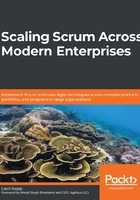
Preface
Scrum is the ascendant leader in Agile practices and the primary topic of this book. But Scrum did not come about on its own, nor by accident. Nor is it the only game in town.
From the beginning, there were other Agile methodologists whose works contributed mightily to Agile-based development values and principles, as outlined in the Agile Manifesto. Many of those early Agile methodologists and practitioners developed so-called "lightweight" software development life cycle practices to overcome the deficiencies of the traditional linear-sequential and plan-driven Waterfall development model.
Scrum became the leader in this industry as a framework that encapsulates the customer-centric, iterative, and incremental development practices of other Agile disciplines, but also brought empirical process control theory (empiricism) to the table to help small development teams resolve complex adaptive problems. Such problems emerge because large and complex systems are difficult to get one's head around and fully understand how their component elements impact the system as a whole.
Scrum fosters a heuristic process that relies on its pillars of transparency, inspection, and adaption to visibly expose problems, experiment on ways to make improvements, and adapt the changes that most improve upon a development team's desired goals. Moreover, Scrum has proven to be a tremendously successful problem-solving framework across numerous applications, well beyond its original roots in software.
The early successes of Scrum drove organizations to implement its Agile-based approach to development at scale and in applications not addressed in the original Scrum Guide™. Many companies and other entities figured out how to make it work, but not without investing significant time and effort. However, the limitations in scaling guidance left the door open for other methodologists to make improvements and modifications to the basic Scrum framework. Additionally, advancements in Systems Thinking and Lean Development provided new tools to further extend the capabilities of the original Scrum framework.
This book provides evidence that Agile practices have become mainstream. However, if being Agile were only about implementing advanced software development strategies, this adoption would never have come about. Instead, modern Scrum and Lean-Agile practices go beyond supporting software development to enable business agility on an enterprise scale.
Business agility is essentially the ability of an organization to evaluate and competitively respond to changes driving both their business and their industry and do so from a customer-centric and value-added perspective. But, on the other hand, the implementation of Scrum and Lean-Agile practices on an enterprise scale involves significant structural and cultural changes that are not trivial to implement.
Ultimately, the combination of business and consumer needs and competition drive major change events across organizations. It is those drivers that are forcing the adoption of Scrum and Lean-Agile practices on an enterprise scale, spanning both product development and delivery activities. And that is what this book is about – installing the right set of Lean-Agile practices, methods, and tools, across both development and operational activities, to remain relevant in a highly disruptive, evolving, and digital world.